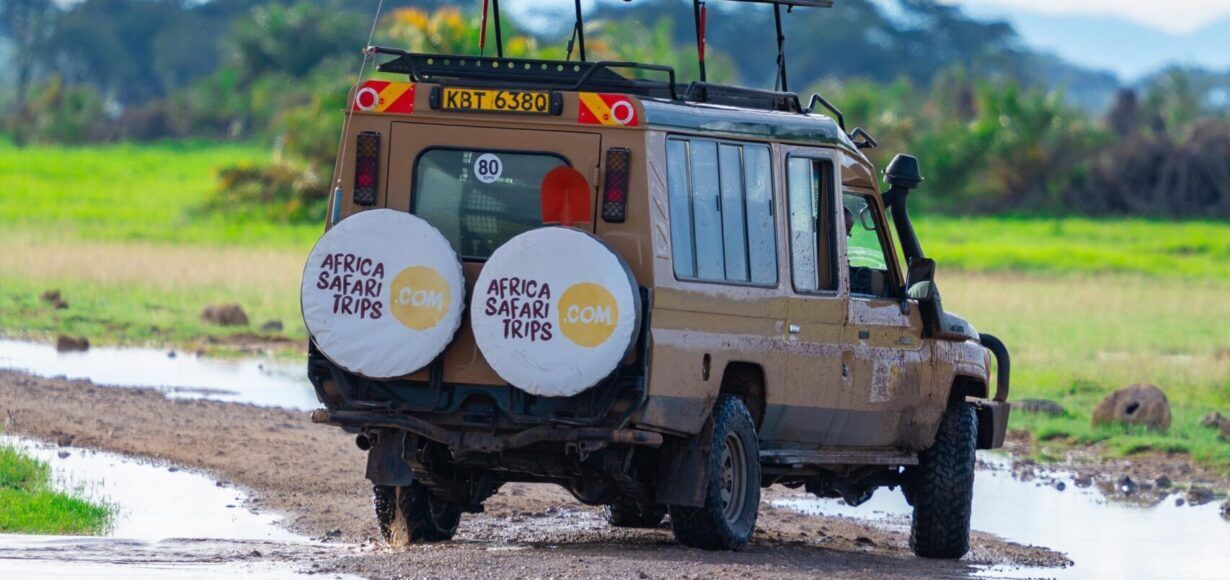A different kind of safari awaits you at the Ol’ Pejeta Conservancy, four hours from Nairobi. With a population of 140 black rhinos, it’s the largest sanctuary for these massive animals in East and Central Africa and heaven for rhino fans. Black rhinos have been acutely threatened with extinction since 1993. At that time, there were only an estimated 2,300 animals left worldwide. Today their numbers have risen again to over 5,000. In Ol’ Pejeta their number has grown from 20 in 1995 to 140 today! In addition, there are also 41 (39 southern and 2 northern) white rhinos living here. Since white rhinos are relatively peaceful and easy to spot, the park offers the opportunity to observe them up close.
The last two Northern white rhinos in the world
Najin and her daughter Fatu are the last two northern white rhinos in the world. Najin was excluded from the breeding program at the end of 2021, which aims to save the species from extinction, because she has become too old (over 30 years old). Fatu is now the only remaining donor in the program, which aims to implant artificially developed embryos into another, more common rhino species in Kenya.
Some rhino knowledge to show off with: the difference between black and white rhinos is not their colour. It comes from a mistranslation of the Afrikaans word “weit”, meaning “wide”, which refers to the wide upper lip of white rhinos they need for grazing. Black rhinos have a hooked upper lip since they prefer to pick their food from bushes. Black rhinos are also smaller, more solitary, shy and aggressive than white rhinos, which is why white rhinos are easier to spot and get close to.
Chimpanzees and other wildlife
The conservancy is home to more wildlife than rhinos. It also hosts all members of the Big Five and many other “regular” safari animals. Endangered species like the African wild dog, the Oryx, Jackson’s hartebeest, Grévy’s zebra, serval, cheetah and the bat-eared fox have a home here.
Last but not least, the conservancy is home to the Sweetwaters Sanctuary. This is a sanctuary for orphaned or abused chimpanzees. Even though these beautiful primates are not native to Kenya, the conservancy is a safe haven for them. They started doing this after another sanctuary in Burundi had to close down due to the war in 1993. Together with the Jane Goodall Institute and the Kenya Wildlife Service (KWS), they managed to continue the good work of giving chimps from all over the world a new safe home.
Activities in Ol’ Pejeta Conservancy
- Go on a safari (you have to!)
- Get close to a white rhino
- Walk the nature trail
- Visit chimpanzees at the Sweetwater Sanctuary
How to get there
By car it takes three to four hours from Nairobi to get to Ol’ Pejeta, with the last 13 kilometres being a dirt road. It’s also possible to catch a flight from Nairobi to the Nanyuki airstrip, after which it’s a mere 45 minute drive to the conservancy.
Climate
Kenya has a cold season from June to November with average temperatures of 20°C during the day. Nights can get cold during this season, so it’s best to take a sweater. Mid-October to November is the short rainy season, after which temperatures rise up to 30°C during the day from December to April. April and May come with showers again as this is the long rainy season. It normally doesn’t rain throughout the day as one sees sunny mornings with rain clouds building up towards the afternoons and evenings.
Best time to visit Ol’ Pejeta Conservancy
June to October and December to March are the best times to visit Ol’ Pejeta Conservancy, as this is the dry season. The rainy season makes it sometimes challenging to drive the dirt roads.
However, take into account that July and August and December are high season, which means it’s busier with tourists. The months of September and October are cooler, dry and less busy, which makes that probably the best time to plan your visit.
Information and facts
Ol’ Pejeta Conservancy is a sanctuary for black rhinos, white rhinos and chimpanzees, but also home to the Big Five and other fascinating wildlife. Meaning: with a visit in this animal safe haven you can not only get close to these animals, but you’ll also support conservation efforts. A classic win-win-situation.
Most common animals
- Black rhino
- Southern white rhino
- Northern white rhino
- Chimpanzee
- Elephant
- Lion
- Buffalo
- Leopard
- African wild dog
- Cheetah
- Grévy’s zebra
- Serval
- Oryx
- Jackson’s hartebeest
- Bat-eared fox
Facts about Ol Pejeta Conservancy Highlights
- 360 square kilometres (140 square miles)
- Largest black rhino sanctuary
- Nearly 200 rhinos
- All of the Big Five and many more animals live here
- Home to the Sweetwater Sanctuary for orphaned and abused chimpanzees















